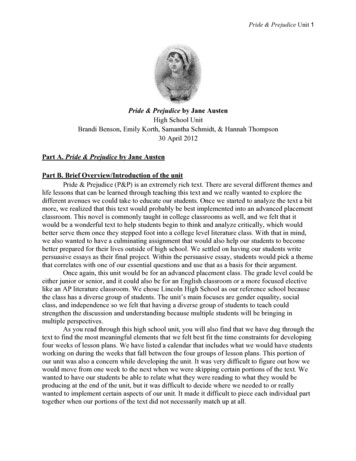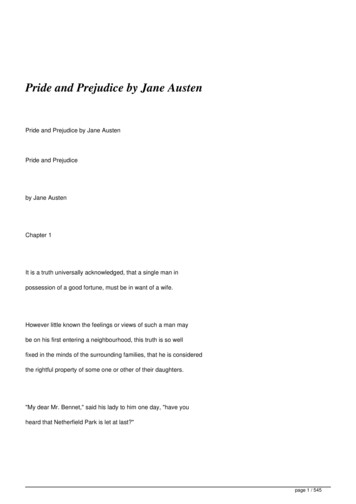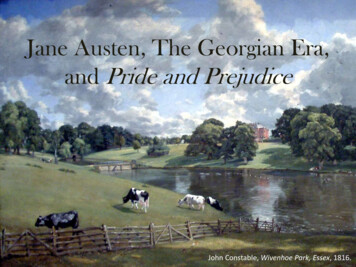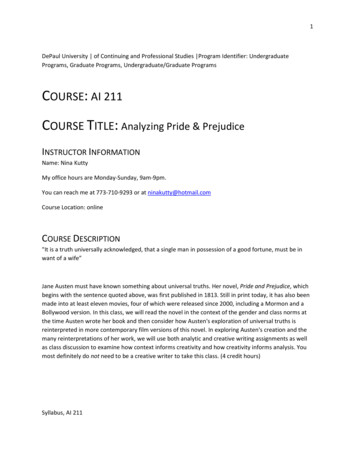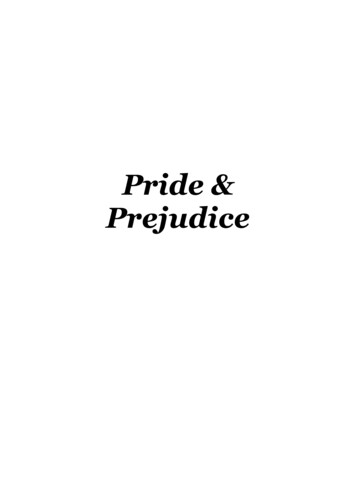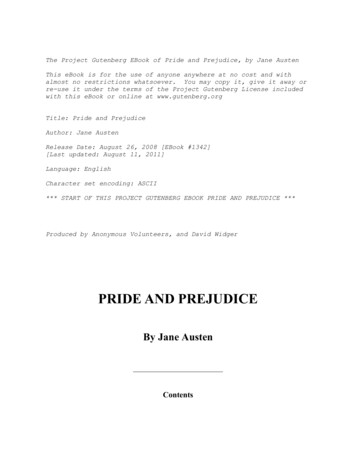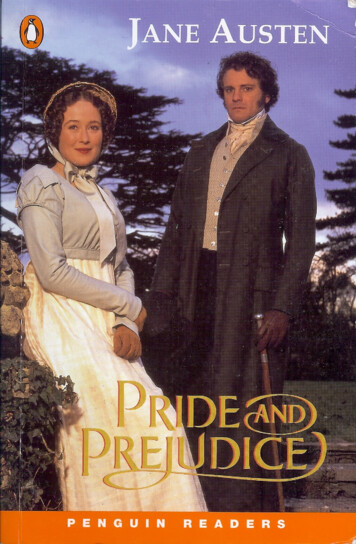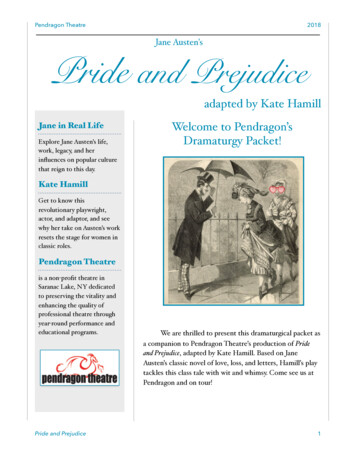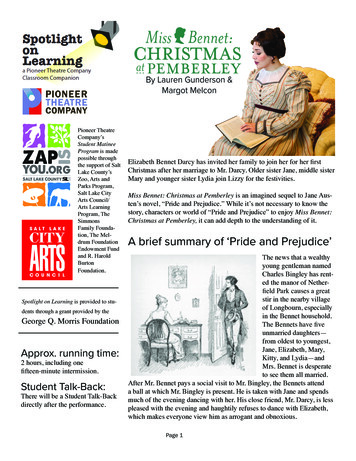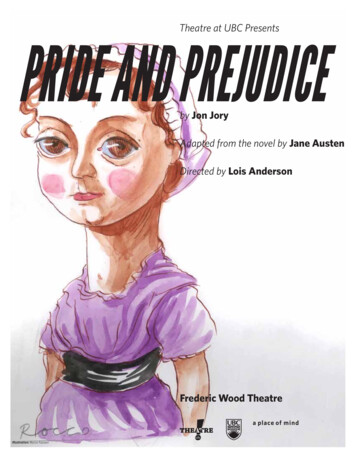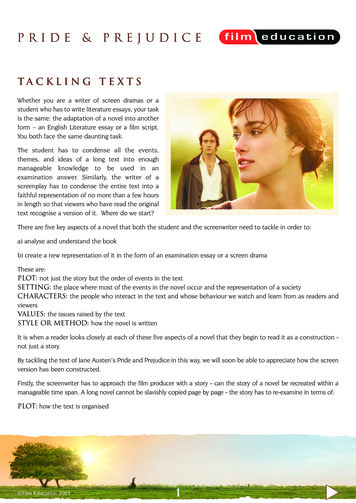
Transcription
TACKLING TE XTSWhether you are a writer of screen dramas or astudent who has to write literature essays, your taskis the same: the adaptation of a novel into anotherform – an English Literature essay or a film script.You both face the same daunting task.The student has to condense all the events,themes, and ideas of a long text into enoughmanageable knowledge to be used in anexamination answer. Similarly, the writer of ascreenplay has to condense the entire text into afaithful representation of no more than a few hoursin length so that viewers who have read the originaltext recognise a version of it. Where do we start?There are five key aspects of a novel that both the student and the screenwriter need to tackle in order to:a) analyse and understand the bookb) create a new representation of it in the form of an examination essay or a screen dramaThese are:PLOT: not just the story but the order of events in the textSETTING: the place where most of the events in the novel occur and the representation of a societyCHARACTERS: the people who interact in the text and whose behaviour we watch and learn from as readers andviewersVALUES: the issues raised by the textSTYLE OR METHOD: how the novel is writtenIt is when a reader looks closely at each of these five aspects of a novel that they begin to read it as a construction not just a story.By tackling the text of Jane Austen’s Pride and Prejudice in this way, we will soon be able to appreciate how the screenversion has been constructed.Firstly, the screenwriter has to approach the film producer with a story - can the story of a novel be recreated within amanageable time span. A long novel cannot be slavishly copied page by page - the story has to re-examine in terms of:PLOT: how the text is organised Film Education 20051
All texts are organised into the following structure:SITUATION: what happens at the beginning of the text - where it is happening, who it involvesPROBLEM: a complication in the form of a conflict or problem takes place that creates some form of tension ordifficulty. The calm order of the situation is disruptedCLIMAX: the complications and problems increase or intensify until at some stage in the text they reach a turningpoint or unbearable limit - in some texts this is where the plot might end - literally as a cliffhangerRESOLUTION: the problems are solved and something similar to (but not necessarily the same as) the original calmand order of the SITUATION is returned to.TA S K 1If you have read Jane Austen’s Pride and Prejudice then see if you can divide the main events of that novel into the plot structure - thesituation, problem, climax and resolution.What were the problems you faced?With a partner, list the difficulties you had and then talk with another pair about them.TA S K 2Using the storyboard on the next page of the guide see if you can devise key images from the text to fit the situation, problem, climax andresolution - one image for each stage of the plot structure. Try to create your own image.If you can, find a passage from the novel that could form the basis for your image.Now compare storyboards. Has anyone chosen exactly the same incidents? How different are your choices?It does not matter if you have taken different episodes - the process of tackling the texts in this way is the same. You are examining plotstructure.The fact is that there are many film and television adaptations of Jane Austen's novels and this itself is a mark of her popularity as wellas her skill as a writer. The film industry tries not to take too many expensive risks and it is clear that, were Jane Austen alive and writingtoday, there would be a scramble amongst the studios to purchase the rights to her next novel. There is no doubt that a film or televisionadaptation of a Jane Austen novel can bridge the gap between the pleasure of reading the novels as romantic comedies and analysing thetexts as social commentaries.TA S K 3 Why do you think that filmmakers and television directors turn to novels to adapt for cinema and television?How do you think that adaptations from novels might attract audiences?What do you think the problems are for adaptations from novels, from the point of view of audiences and also critics?What is the most common complaint raised about adaptations? Film Education 20052
ADAPTING AUSTENReading books and reading films involves the same process: anindividual reader brings expectations, assumptions, knowledge andexperience to a text and the characteristics of that particular book orfilm produce a response.W H AT D O W E B R I N G TOPRIDE AND PREJUDICE?Let’s now consider some of the things that an audience might bring toa screening of Pride and Prejudice.Because Pride and Prejudice is a mixture of different types of storytellingtechnique, let us consider what each type or ‘genre’, might make usexpect:So, consider the following: A romantic film A Jane Austen novelIf a member of an audience had knowledge of only one of these thenwhat would that knowledge, those expectations be? List theexpectations that you have for each of these types of stories.The novel and the film Pride and Prejudice takes a basic story and developsit into a structured narrative. The basic story can be explained as follows: Boy meets girl (or girl meets boy) boy loses girl, boy gets girl – theclassic romantic story.It is now important to look at the ways in which an author or scriptwriter willtake this basic formula and fill it out with characters, events and themes.TA S K 1In no more than 100 words, write a short summary of the film Pride and Prejudice.TA S K 2Once you have completed this, you will be given a summary of the novel (StudentSheet A). What have you not included in your summary? Which elements of thenovel’s plot do not appear in the film?Try to give reasons why you and the filmmakers missed out certain parts of the plotof the novel. Film Education 20053
AUSTEN AND THE SCREENWhat is it about Pride and Prejudice that still makes it so attractive tofilmmakers?TA S KHere are some of the reasons why an adaptation of Pride and Prejudice is still likelyto succeed. The task is to decide which you feel are the most important factors bynumbering them one to ten (one being the highest score). Follow this by discussingyour choices and determining a definitive list in order of importance.Having decided which are the most important aspects of the novel and its placewithin film production, write down why you feel the world is ready for a new screenversion of Pride and Prejudice.PITCH FACTORSORDER OF IMPORTANCEIt remains one of the best-loved tales, in the top ten of English readers’ choiceswhen asked to list their favourite novels.There is a wealth of character actors in Britain able to provide the kind ofacutely observed cameo performances needed to make Pride and Prejudice’scast come alive.Its most recent TV adaptation in the mid-nineties was hugely popular both in theUK and abroad. Far from being a reason for steering clear, any new version of thenovel is likely to benefit from the collective awareness the BBC series helped tocreate and into which the new project can tap.The novel Pride and Prejudice is set in the early nineteenth century. However isultimately a classic love story, in which a hero and heroine overcome obstacles,many of their own making to find true love. As a romance it has the universalappeal of a recognisable genre. As a story it deals with timeless issues that arerelevant to today.The fact that Keira Knightley agreed to play Elizabeth Bennet. She is a star withthe capacity to guarantee an audience – a rare thing in an English actress. Therole comes at an important time for her, providing an opportunity for the kindof nuanced performance that is impossible in blockbuster films like Pirates ofthe Caribbean. Film Education 20054
PITCH FACTORSORDER OF IMPORTANCEDarcy is one of the most romantic heroes in fiction. He embodies many fantasyelements, not least the need to be freed from constraining emotional bondsthat initially render him aloof and judgemental.Yes, Pride and Prejudice depicts a lost world in which class and deference wereparamount, but its air of gentility and quiet humour is enough to make itdistinctive. It has a strong nostalgic appeal that should translate into good boxoffice in the UK, US and other important marketplaces.Recent adaptations of Emma, Sense and Sensibility and Mansfield Park haveset the stage for a screen version of Austen’s most famous novel.The fact that established screen actors such as Judi Dench and DonaldSutherland have agreed to take the roles of Lady Catherine De Bourgh and MrBennet respectively will draw in an audience. Donald Sutherland’s presencegives the project an all-important American star to feature in the publicity.There are superb locations in Britain, in which Georgian settings can be createdat a fraction of the cost of building sets. Among these is the spectacularChatsworth House in Derbyshire which is to be used as the setting forPemberley, Darcy’s family seat in the Peak District.It is a comedy. There are some superbly amusing characters such as Mrs Bennetand Mr Collins. Also in keeping with a comedy, it ends happily which isrefreshing at a time of anxiety. Film Education 20055
ROMANTIC GENREGenres are formal systems fortransforming the world in which weactually live into self-contained andcontrollable structures of meaning. . they shape reality, thus making itless random and disordered.’Patrick Phillips: An Introduction To Film Studies(Editor: Jill Nelmes)THE PLEASURES OF GENRESMany stories are formulaic. They follow a set formula or pattern. They start and end in quite a predictable way and yetthey still have the power to entertain the audience because they contain unexpected elements.This mixture of the predictable and the unexpected is a very useful way of starting to understand film genres. Part ofthe reason film genres survive is because they are able to offer audiences a mix of the pleasantly familiar and theunusual.We have already mentioned that when we go along to see a film we will have expectations of what we are going to see.These expectations will relate to the genre, or type of film, that we are seeing.What do you think makes romantic fictions, whether novels or cinematic, very popular? As an audience we expectcertain things to happen in romantic stories. Which will lead us to one of two endings – either happy or sad. Whatinterests us is the ways in which the story itself is constructed to arrive at one of these possible endings.TA S KIn Pride and Prejudice, what do you think are the key storylines that interest us and keep us both reading and viewing the story?Many of the ingredients are present in both the novel and its film version. If you know the novel well, use the table on page 7 to remindyourself of some of the main elements that make up the romantic narrative. If the film is your first encounter with the story, then fill inthe grid based on your recollection of what you have seen.Once you have completed the chart for Pride and Prejudice, you should then think about other romantic films that you have seen recently.Do the conventions outlined above hold true for all romantic comedies? Film Education 20056
GENERIC ROMANTIC ELEMENTSPRIDE AND PREJUDICE INCIDENTA heroine – lively and attractive, though perhaps notobviously so. At the start her circumstances may not beideal. She may lack advantages that might smooth herpath in life and love.A hero – ideally tall, dark and handsome. He may have apast, one that continues to colour his present, makinghim seemingly aloof and unattainable. His circumstances(social standing) may also set him apart.Early misunderstandings. Despite the hero and heroinebeing eminently suitable for one another, their initialcontacts are not happy ones. The differences betweenthem seem to predominate and circumstances seem toconspire against them.The family as obstacle. Families are often a major sourceof impediments in romantic fiction. Both the hero andheroine’s families might prove problematic. There aremany ways families can interrupt the course of true love,but one of the main ones is in undermining the heroine orhero’s love in some way or by demanding that theychoose different partners in life.Misunderstandings. The hero and heroine might be drivenapart by their misreading or misinterpretation of oneanother.Rivals as obstacles. The hero and heroine might well needto see through the allure of possible love rivals. Thesecharacters may pose an illusory threat, but for a whilethey will seem like real challengers for the hero orheroine’s affections.The crucial meeting(s). At some point the hero andheroine might meet in a context outside of their normalenvironment. Freed from some of the social constraintsand conventions that hampered them in the past, theyare able to read one another more clearly. Film Education 20057
GENERIC ROMANTIC ELEMENTSPRIDE AND PREJUDICE INCIDENTTrials and tribulations. Circumstances will arise that testthe love of hero and heroine. The hero may well berequired to make a sacrifice or perform a trial that securesthe heroine’s affections.The happy ending. There will be a coming together for thehero and heroine. The strength of their marriage will beborn of the trials and tribulations they have overcome.Against the pattern of mutual respect and love theyachieve, other relationships are clearly to be seen to bewanting. Their love marks a triumph over narrowmindedness and societal pressures. Film Education 20058
JANE AUSTEN AND THE EARLYNINETEENTH CENTURYIf you have some understanding of the society in which Jane Austenlived and her own preoccupations, then you are more likely torespond confidently.WOMEN, MONEY AND MARRIAGETA S K 1Read the opening of Pride and Prejudice and underline any words or phrases thatare to do with money and property, marriage and social position. Now searchthrough the passage to find any obvious contrasts or oppositions that might beginto reveal what this novel is going to be about.PRIDE AND PREJUDICECHAPTER 1It is a truth universally acknowledged, that a single man in possession of a good fortune must be in want of a wife.However little known the feelings or views of such a man may be on his first entering a neighbourhood, the truth isthis much is so well fixed in the minds of the surrounding families, that he is considered as the rightful property ofsome one or other of their daughters.‘My dear Mr Bennet,’ said his lady to him one day, ‘have you heard that Netherfield Park is let at last?’ Mr Bennetreplied that he had not.‘But it is,’ returned she; ‘for Mrs Long has just been here, and she told me all about it.’ Mr Bennet made no answer.‘Do not you want to know who has taken it?’ cried his wife impatiently.‘You want to tell me, and I have no objection to hearing it.’This was invitation enough.‘Why, my dear, you must know, Mrs Long says that Netherfield is taken by a young man of large fortune from the northof England; that he came down on Monday in a chaise and four to see the place, and was so much delighted with itthat he agreed with Mr Morris immediately; that he is to take possession before Michaelmas, and some of his servantsare to be in the house by the end of next week.’‘What is his name?’‘Bingley.’ Film Education 20059
‘Is he married or single?’‘Oh! single, my dear, to be sure! A single man of large fortune; four or five thousand a year.What a fine thing for our girls!’‘How so? How can it affect them?’‘My dear Mr Bennet,’ replied his wife, ‘how can you be so tiresome! You must know that I am thinking of his marryingone of them.’‘Is that his design in settling here?’‘Design! Nonsense. How can you talk so! But it is very likely that he may fall in love with one of them, and thereforeyou must visit him as soon as he comes.’‘I see no occasion for that. You and the girls may go, or you may send them by themselves, which perhaps will be stillbetter, for as you are as handsome as any of them, Mr Bingley might like you the best of the part.’‘My dear, you flatter me. I certainly have had my share of beauty, but I do not pretend to be anything extraordinarynow. When a woman has five grown up daughters, she ought to give over thinking of her own beauty.’‘In such cases, a woman has not often much beauty to think of.’‘But, my dear, you must indeed go and see Mr Bingley when he comes into the neighbourhood.’‘It is more than I engage for, I assure you.’‘But consider your daughters. Only think what an establishment it would be for one of them. Sir William and Lady Lucasare determined to go merely on that account, for in general you know they visit no new comers. Indeed you must go,for it will be impossible for us to visit him, if you do not.‘You are over scrupulous surely. I dare say Mr Bingley will be very glad to see you; and I will send a few lines by you toassure him of my hearty consent to his marrying which ever he chuses of the girls; though I must throw in a good wordfor my little Lizzy.’‘I desire you will do no such thing. Lizzy is not a bit better than the others; and I am sure she is not half so handsomeas Jane, nor half so good humoured as Lydia. But you are always giving her the preference.’‘They have none of them much to recommend them,’ replied he; ‘they are all silly and ignorant like other girls; butLizzy has something more of quickness than her sisters.’‘Mr Bennet, how can you abuse your own children in such a way? You take delight in vexing me. You have nocompassion on my poor nerves.’‘You mistake me, my dear. I have a high respect for your nerves. They are my old friends. I have heard you mentionthem with consideration these twenty years at least.’Pride and Prejudice, Jane Austen (Oxford World's Classics, 2004) Film Education 200510
TA S K 2Look at extract one from the film study extracts and try to identify how the filmmaker has tried to capture these ideas on screen.When Jane Austen was writing, marriage was much more than a contract between two people who love each otherenough to want to spend their lives together. In fact, love might not even have been a consideration. For women,marriage gave the only form of financial security. Legally, married women owned nothing; all money and propertybelonged to their husbands. In families with sons, there was little complication about who inherited the wealth - theeldest son. Daughters had to be allocated a portion of the family’s wealth (a dowry) but this was really for use asbargaining power in the marriage marketplace.During Jane Austen’s short life (she was born in 1775 and died in 1817), there were many important events andchanges in society. The most obvious point to make about her life is that it bridged the eighteenth and the nineteenthcenturies. As far as literary history is concerned, there was a gradual change in attitudes and philosophy which alsospanned the two centuries, so that it is possible to recognise typical eighteenth century views reflected in bookswritten in that century as well as views typical of the nineteenth century. Broadly speaking, the eighteenth century hasbeen called ‘The Age of Reason’ - the age of sense when there was a belief in a ‘right way’ for the universe to workand in ‘true’ human behaviour. The nineteenth century saw a gradual move away from ‘reason’ towards human instinctand feeling, so that it became known as ‘The Age of Romanticism’ with the emphasis on sensibility. The influence ofthis transition was broad reaching affecting attitudes to art, architecture, music, philosophy as well as literature.Ta s k 3Draw a time line that begins in 1775 and ends in 1817. Using as many sources as possible, try to find out some of the main historicalevents that took place throughout Jane Austen’s lifetime. Now discuss what you can remember of the film and how accurate a portrayalof early nineteenth century England it is. You might discuss some of the following topics: fashions, the presence of the military, social classdifferences etc. Film Education 200511
CHARACTERSOne of the key elements of storytelling is the characters in the story. A novelist or filmmaker has to create believableand interesting characters in order to involve the reader/viewer in the story.The major techniques used by writers and filmmakers to establish a character and to help us understand what type ofperson they are include: Physical description (including dress, looks, voice)Personality (friendly, happy etc.)Actions of the characterInteraction with other charactersComments on other charactersCharacters are essential to the movement of a story. As a story is a construction and everything within it should berelevant to its development, then we can see that the actions, thoughts and words of any character are a vital elementof the dynamic of a story.In the novel, ‘character’ means one of two things. Firstly it is used to refer to the imaginary people that populate thenovel. Talking about character however, can also refer to a psychological judgment of some kind. Bingley says toElizabeth, ‘I did not know before, that you were a studier of character, it must be an amusing study.’ (Ch 9). The studyof a person’s character; in other words their personality, ethics and manner of conducting themselves is a matterdiscussed frequently in the novel. True judgment of character is exhorted as a valuable skill, especially by Mr Bennetwhen he is giving advice to his daughters.Readers are able to exercise their own character judgments. For example, the easy-going Bingley is a simpler characterto understand. He is polite and affable to everybody. Whereas Darcy is a more intricate character. His actions seem tobe controlled by a struggle between his decency and his pride, the latter often resulting in antisocial behaviour.How far does this hold true for the film?Jane Austen is economic in her descriptions of characters. This is to the advantage of filmmakers who have morefreedom when it comes to their casting decisions.In the next exercise, use the table on page 13 to collect and analyse descriptions of Elizabeth from the novel. We havegiven you four descriptions to start you off. Film Education 200512
DESCRIPTIONS/INCIDENTSSIGNIFICANCECHAPTER 20Mr Bennet: ‘An unhappy alternative is before you,Elizabeth. From this day you must be a stranger to one ofyour parents. Your mother will never see you again if youdo not marry Mr Collins, and I will never see you again ifyou do.’Elizabeth could not but smile at such a conclusion ofsuch a beginning; but Mrs Bennet, who had persuadedherself that her husband regarded the affair as shewished, was excessively disappointed.CHAPTER 3Mr Bingley: ‘But there is one of her sisters sitting downjust behind you, who is very pretty, and I dare say, veryagreeable ’Mr Darcy: ‘She is tolerable, but not handsome enough totempt me.’CHAPTER 3Elizabeth remained with no very cordial feelings towardshim. She told the story afterwards, however with greatspirit among her friends, for she had a lively, playfuldisposition, which delighted in anything ridiculous.CHAPTER 4Lizzie: ‘Oh! You are a great deal too apt, you know, to likepeople in general. You never see a fault in any body. Allthe world are good and agreeable in your eyes. I neverheard you speak ill of a human being in my life.’Jane: ‘I would wish not to be hasty in censuring any one;but I always speak what I think.’ Film Education 200513
TA S KCome up with a series of key words describing Elizabeth. Write them in the space around the still image of Keira Knightley in the rolegiven below.E X T R A C T TA S KLook carefully at extract one from the film study extracts which shows the opening of the film.The opening of the film shows Elizabeth outdoors as day breaks. What impression do you gain of her from this brief sequence? What mightit signify that her arrival is heralded by the sound of the dawn chorus (as opposed to the geese that seem to surround her house) and thatshe is pictured against the dawn?How do these opening shots of Elizabeth in natural surroundings, anticipate other times when she is shown to be outside? Film Education 200514
A C T IO N S A N D M OT I VAT IONHaving looked at the physical and personality aspects of the characters we should now look at their motivation andalso their actions in order to see how each character relates to the other characters.TA S KIn the chart below you will be required to choose three key actions for each of the main characters. For each of these actions you shouldthen try to say what each of them tells us about the character. Finally, you could think of the ways in which this particular actionaffects other characters.WHAT THE ACTION TELLS USABOUT THE CHARACTERREFLECTION INOTHER CHARACTERSCharacter 1:123Character 2:123Character 3:123 Film Education 200515
TA S K 1Consider how the characters interact with each other.See if you can draw a diagram that links the characters together.When you have drawn your diagram try to think of key moments in the film that relate to each relationship.OTHER CHARACTERSPride and Prejudice derives a great deal of its appeal from the large number of characters that surround the centralcouple, Elizabeth and Darcy. It is important to realise that each of the minor characters who appear in the novelcontribute to the overall story and themes.TA S K 2Why have so many other chartacters been included? How do they help move the story along?Choose three of the minor characters from the story and decide why both Austen and thefilmmakers decided to include them in the story.Firstly we want you to think about each character individually. For each of the three charactersanswer the following: Describe the physical characteristics of the characterTry to describe their personalityWhat do we know about the background of the character?The next thing to look at is how you have come to understand this. For your answers try tothink of moments within the film that illustrate the points you have made.TA S K 3In a small group, discuss which characters in the film were meant to be amusing and which were meant to be rather unattractive. Findreferences to these characters in the novel and compare the way Austen presents them to the way the actors interpreted their roles. Listthe characters according to their allegiance to pride or prejudice. Film Education 200516
THEMESWe are now going to explore the ideas of themes within the storyof Pride and Prejudice. Earlier in this guide you will have written ashort summary of what happened in both the novel Pride andPrejudice and also in the film Pride and Prejudice. When we talkabout themes of a story we are not talking about what happenedbut what the story is about and what the events illustrate.So, now try to write one hundred words that would tell someonewhat the film is about. One thing you might say is that the film is‘about’ marriage. This will lead you on to some of the otherthemes in the film. If you have studied the novel, you should thenrepeat the same exercise, trying to say what the novel is about.You will probably find that marriage crops up again!Once you have the two lists of themes, compare them to see whether the film has stuck to the themes of the novelin the new-filmed version of the story. Are there any differences? Can you account for these?Below are some of the themes that appear in both the novel and the film Pride and Prejudice. ValuesPridePrejudice Economic statusMoney and self-interestMarriage and loveClass and wealthThe role of womenNarrowness of visionTA S KIn the chart below write down four of what you think are the themes of the film. Next to each theme try to write down at least two incidentsfrom the film that illustrate that theme.THEMEINCIDENTS IN FILM1234 Film Education 200517
A SENSE OF PLACEAs has already been mentioned, a romantic story often needsa fairly tight set of locations in which to be played out. Thissense of enclosure, or claustrophobia, was potentially highlypronounced in Jane Austen’s day when travel was bothexpensive and time-consuming. For example, in the novel twoweeks is deemed too short a time for Elizabeth and Mr and MrsGardiner to reach the Lake District from Southern England.They have to make do with Derbyshire – with all sorts ofunforeseen incidents flowing from that change in itinerary.One of the main ways in which the screen version of Pride andPrejudice is able to bring home the social and characterdistinctions between people is through their domestic settings.FORMAL AND INFORMALStudy the opening sequence in which we are taken on a tourof the Bennet’s home Longbourn. What indications are therethat this is neither a well managed or disciplined household?What impressions are there that the house is very muchadjacent to farming activity? Can you think why thefilmmakers, adopted these indicators of the Bennet’s inferiorstatus over the distinctions in sizes of parlours, gardens ordeliberate areas of wilderness that are mentioned in the novel?Again – late in the film identify the ways in which the Bennetshave to modify their behaviour in the sitting room before theycan receive Mr Darcy and Mr Bingley. What is required of thewomen in terms of their dress, deportment and behaviourbefore the gentlemen can be admitted?Contrast the appearance of Longbourn and its inhabitants withthat of Netherfield and the party there. Consider the way inwhich the scenes in which Elizabeth is greeted after her crosscountry walk or when Darcy is depicted writing to his sisterGeorgiana are arranged deliberately to emphasise the stagedelegance of the scenes and their inhabitants. Film Education 200518
OTHER CRUCIAL SETTINGSHUNSFORD – how does the film use the environment of the parsonage to suggest the emotional space that hasbeen quickly established between Caroline Lucas (as was) and her husband Mr Collins?ROSINGS – the novel suggests that Lady Catherine’s home is reflective of the kind of dr
version of Pride and Prejudice. PITCH FACTORS ORDER OF IMPORTANCE It remains one of the best-loved tales, in the top ten of English readers ' choices when asked to list their favourite novels. There is a wealth of character actors in Britain able to provide the kind of acutely observed cameo performances needed to make Pride and Prejudice's
